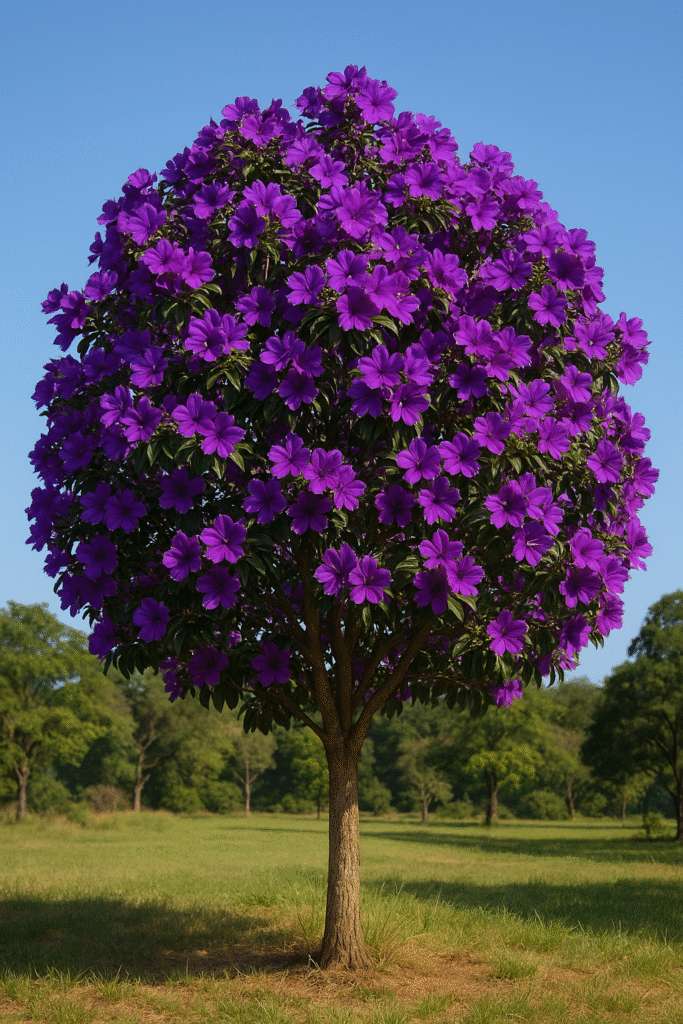The Serra glory tree, known in Portuguese as quaresmeira da serra, is a native Brazilian tree celebrated for its vibrant purple or pink flowers, especially during its blooming season. Scientifically named Tibouchina sellowiana, it belongs to the Melastomataceae family and is highly valued for both its ornamental appeal and its ecological importance in the mountainous regions of the Atlantic Forest.
This tree is commonly associated with the Christian liturgical season of Lent, as its main bloom happens around that time—hence the name “quaresmeira,” which refers to Lent in Portuguese. Beyond its visual beauty, the Serra glory tree is also a sustainable option for reforestation and urban landscaping projects.
Key Features of the Serra Glory Tree
The Serra glory tree is a medium-sized tree, typically growing between 6 to 12 meters tall, depending on climate and soil conditions. It has a slender trunk and a well-structured canopy with harmoniously spreading branches.
Its leaves are simple, with a deep green color, rough texture, and prominent veins. However, the tree’s main attraction lies in its large, vibrant flowers, which range from deep violet to soft pink depending on the variety and environment. Blooming usually occurs between January and April, which aligns with the Lenten season in Brazil.
The flowers grow in dense clusters that often cover most of the tree’s canopy, forming a breathtaking floral display. When the petals fall, they create colorful carpets on the ground, adding to the visual impact of the landscape.
Natural Habitat and Distribution
The Serra glory tree is endemic to the Atlantic Forest, especially in mountainous areas of southern and southeastern Brazil. It’s commonly found in secondary forests, forest edges, and high-altitude fields.
It thrives in tropical and subtropical climates, preferring mild temperatures and well-drained soils. The tree is hardy and can tolerate light frost, making it well-suited for cultivation in highland areas.
Ecological Importance
More than just an ornamental plant, the Serra glory tree plays a crucial role in its native ecosystem. Its flowers attract native bees, butterflies, and hummingbirds, aiding in pollination and supporting local biodiversity.
Because it’s a native species, it contributes to the ecological balance and serves as food and shelter for small animals. The Serra glory tree is often used in reforestation efforts due to its adaptability and ability to improve soil conditions and provide early-stage shading in restoration projects.
How to Grow and Care for It
Growing a Serra glory tree does not require expert gardening skills, but it does need some essential care:
- Location: Choose a spot with full sun exposure. The tree needs at least 6 hours of sunlight daily to bloom abundantly.
- Soil: Prefers fertile, slightly acidic soil rich in organic matter. Avoid waterlogged areas by ensuring good drainage.
- Watering: In the first few months after planting, water the tree regularly, especially during dry spells. Once established, it becomes more drought-tolerant.
- Fertilizing: Apply organic fertilizer, such as compost or worm humus, once a year to keep the tree healthy and encourage blooming.
- Pruning: Light pruning after the flowering season helps shape the canopy and remove dead or weak branches.
Landscaping Uses
Thanks to its beauty and manageable size, the Serra glory tree is widely used in urban landscaping, including sidewalks, public squares, and private gardens. Its canopy is non-invasive, so it doesn’t interfere with buildings or overhead wires, and its root system is safe for sidewalks and paved surfaces.
Its extended and vibrant bloom season makes it a perfect visual centerpiece for gardens and cityscapes alike.
How It Differs from the Common Glory Tree
It’s important to distinguish the Serra glory tree (Tibouchina sellowiana) from the more commonly planted Tibouchina granulosa. The latter typically has a taller structure and darker flowers, while T. sellowiana is more delicate and especially suited to cooler, mountainous areas. Both belong to the same genus but differ in appearance and ideal growing conditions.
Conclusion
The Serra glory tree is a magnificent choice for anyone looking to combine native biodiversity with aesthetic appeal. Its dazzling flowers, resilience, and ecological benefits make it ideal for reforestation projects, home gardens, and urban beautification.
Planting this tree is not only a tribute to Brazil’s natural richness but also a meaningful way to create vibrant, sustainable landscapes.

Beat the heat and light up your nights with the Camping Fan with Light. Featuring a massive 20,000mAh rechargeable battery, 8 speeds, up to 112 hours of run time, auto oscillation, and a 270° pivot — perfect for camping, power outages, and emergencies.
Get Yours NowAdd elegance to your garden with the Queen Palm (Syagrus romanzoffiana). Discover its tropical beauty, growth tips, and how to keep it thriving year-round.
Read the Queen Palm Guide
